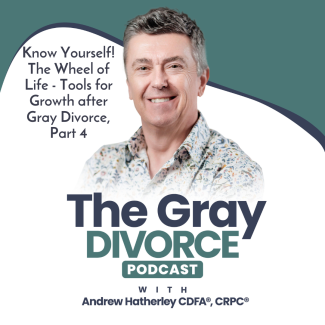
The Gray Divorce Podcast: Episode 30 Know Yourself! The Wheel of Life - Tools for Growth after Gray Divorce, Part 4
In episode 30 of The Gray Divorce Podcast, we finish our four-part series on the tools of positive psychology.
The wheel of life is a very popular tool used in personal coaching. It's sometimes referred to as the wheel of success or the coaching wheel or even the life balance wheel.
It is seen as a tool to help people assess their satisfaction or dissatisfaction with different domains of life and to help people set goals.
Many psychologists argue that our life is out of balance when our basic psychological needs are no longer being met. A common example would be if you were focusing too much on work while your relationship with your family deteriorates or maybe you are prioritizing your finances over your spiritual growth. It's been argued and I think this is probably accurate that this can cause real harm to both your body and mind and bring on a lot of stress.
Proponents of the wheel of life would argue that an appropriate balance between the various areas of your life will enhance your overall well-being.
The Wheel of Life is a very simple tool. Imagine a pie or just a circle with ten slices in it. Each one of these slices or segments represents a different life domain.
These might include:
- Career and work
- Health and fitness
- Family and friends
- Romantic partners and love
- Money and finances
- Spirituality
- Fun and leisure activities.
- Our environment
- Growth and learning
- Spirituality
Within each slice of pie, segments are numbered from one to 10, one being the closest to the center of the circle and 10 being on the outer edge of the circle. Once you've identified these important life domains, you then can rate these areas on a scale of one to 10 with one being “not at all satisfied” to 10 being “completely satisfied.”
This provides you an opportunity to review the wheel, to consider its overall shape and the level of balance inside the wheel.
You might ask yourself how you feel about the shape of the wheel.
What surprises you the most?
What would you want to change the most with respect to the shape of the inner wheel?
Which category of your life domain would you most like to improve?
What do you need to do to improve a low level of satisfaction in any particular area?
Is there something you could do in one area that would improve more than one other area? For instance, and this is rather obvious, but perhaps spending less time on work would improve the family and spiritual dimension of your life. However, would there be an offsetting effect perhaps on the financial area of your life? These are the types of questions you need to ask yourself.
It's important to view this tool as a snapshot of the present moment. It gives you some information about the now and may point to gaps between your current situation and what you want for the future. In this sense it's a good tool to come back to periodically to review how your life might transform over time.
You should revisit the wheel over time and re-score it to understand the changes made and the actions outstanding.
Ongoing check-ins are also helpful to understand overall patterns of behavior and any negative thoughts or emotions that are blocking the changes.
Also, it’s important to understand that balance is rarely retained for long. Circumstances and priorities change; the aim is to continue the journey toward balance and avoid entering a fixed mindset that prevents transformation.
Resources
https://positivepsychology.com/wheel-of-life-coaching/
https://www.mindfulcoachingtools.com/free-tools/p/the-wheel-of-life

